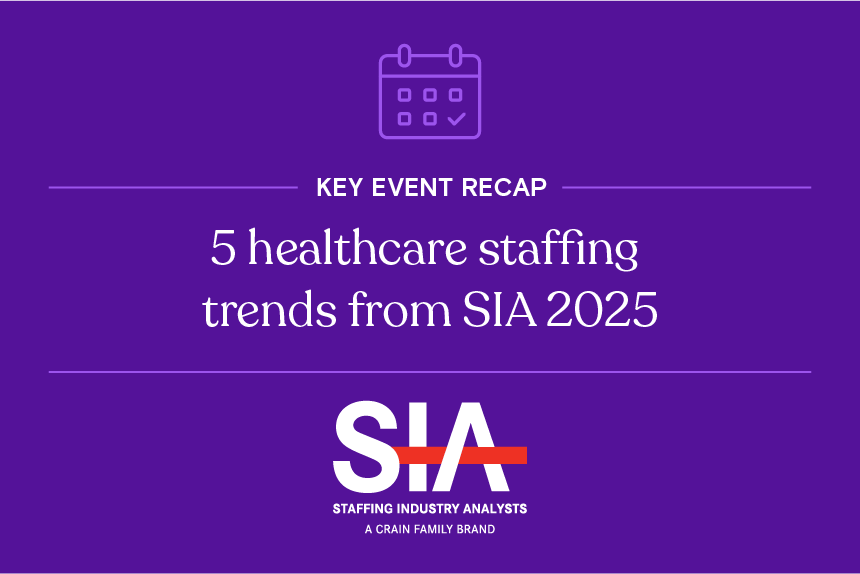The physician shortage is here—and it’s about to get worse.
Thanks to COVID-19, healthcare organizations across the country are already feeling the negative effects caused by staffing shortages, with providers experiencing higher levels of burnout and hospitals increasingly postponing elective surgeries.
The problem will likely get worse, as the U.S. anticipates a 100,000-provider shortage by 2030.
Currently, providers are retiring at a higher rate than new candidates are entering the job market.
In the coming years, it will be more challenging to recruit top talent. By leveraging healthcare commercial intelligence, your organization can stay a step ahead of physician shortages.
Here are three ways healthcare commercial intelligence can help aid with staffing and recruiting today:
Understand your current and future staffing needs
Before you can build a recruiting strategy, you first need to know what staffing gaps exist within your organization.
Claims data can unlock powerful healthcare commercial intelligence to help you identify what specialties might be overworked or understaffed. By evaluating the number of affiliated physicians within a specialty compared to the number of claims the physicians appear on, you can gain a sense of which specialties have the highest inpatient and outpatient workloads.
Specialties with higher volumes of claims but fewer providers associated with them could represent a potential staffing opportunity. These physicians are more likely to be overworked, leaving them at risk for higher levels of burnout.
By coupling claims data with quality metrics, you can also identify other areas within a hospital where staffing gaps may exist. For example, if a hospital’s readmission rate for COPD continuously increases, it might be time to consider hiring more pulmonologists, as the current staff might not have the bandwidth to provide appropriate levels of care to each patient.
When you proactively monitor where and how physicians are overworked, you can build a smarter recruiting strategy and make hiring decisions that will have the most beneficial impact on your providers and patients.
Identify new opportunities to source candidates for open positions
The Great Resignation is upon us, and healthcare is not exempt. Providers are leaving the industry at record numbers, shifting the power from employer to employees as demand for providers increases.
When you have open positions, candidates aren’t necessarily going to find you; you need to find the candidates.
Access to physician data such as graduation year, credentials, board certifications, primary specialty and location can help you proactively identify providers at other facilities who you might want to target for recruitment.
With our PhysicianView product, not only do you gain detailed intelligence that allows you to understand a provider’s areas of expertise, but you can also find the contact information necessary to get in touch with them. This allows you to build a robust outreach strategy targeted precisely to the type of providers who are a fit for your role.
Make your healthcare organization stand out in a crowded field
In a candidates’ market, you need to make your healthcare organization stand out from the crowd. Today, job seekers are looking for competitive benefits and growth opportunities within their fields.
Healthcare commercial intelligence can help you make a great first impression by allowing you to reverse engineer job board postings. Instead of posting a generic job opening, imagine being able to tell a physician exactly what type of patients they’ll see, down to the most common diagnosis and procedure, or being able to list the specific technology they’ll use on a day-to-day basis. Claims data is particularly valuable in bringing in the real-world context to the job posting.
With healthcare commercial intelligence, candidates can get the information they need to understand if a job is a right fit for them before applying, while hospitals can find qualified candidates with the relevant skill sets faster.
Streamlining the onboarding process can also help you stand out in a candidates’ market. Providers have the leverage to be selective in which offers and staffing agencies they choose to work with. A faster, more efficient onboarding process can make a big difference to a candidate evaluating different opportunities.
By leveraging claims data, staffing organizations can export a candidate’s case logs to reduce the time and cost of credentialing providers. Not only does this make the process quicker for the hiring agency, but it also reduces the administrative burden on the candidate—a win-win situation for all parties.
Learn more
Planning for ways to help staff and recruit is a must in a physician shortage and helps to improve patient care overall.
Want to learn more about how healthcare commercial intelligence can address your staffing needs?
Check out our the replay of our recent webinar “How to Staff and Recruit in a Physician Shortage” or book a free demo.




